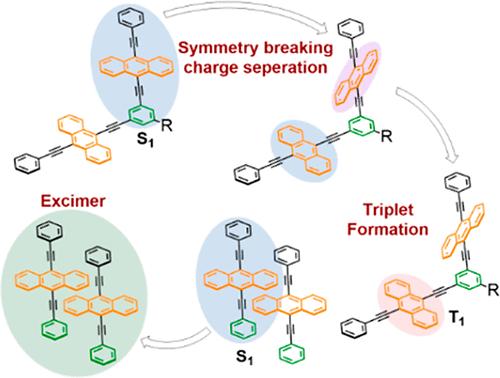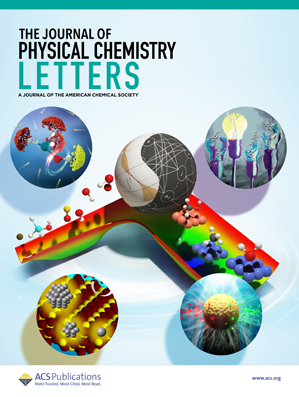9,10-二(苯乙基)蒽二聚体和三聚体中的三重态是通过电荷重组而不是单线态裂变形成的
IF 4.8
2区 化学
Q2 CHEMISTRY, PHYSICAL
引用次数: 0
摘要
我们提出了一项实验研究,研究了9,10-二(苯乙基)蒽单体、二聚体和三聚体的溶剂依赖性动力学。利用瞬态吸收光谱,我们发现极性溶剂中二聚体和三聚体分子的三重态激发态形成是电荷分离对称性破坏后的电荷重组的结果,而不是单线态裂变。单体的全内反射发射测量表明,准分子形成是高浓度下的主要衰变途径。在三聚体的高浓度溶液中,我们观察到三重态形成的证据,而没有事先形成电荷分离态。我们假设这是由于小聚集体的形成,这表明在晶体中模仿较大的发色团计数的低聚物可能潜在地促进单线态裂变。我们的实验研究揭示了9,10-双(苯乙基)蒽体系的复杂动力学,阐明了溶剂和浓度依赖性因素在三重态形成和电荷分离中的作用。本文章由计算机程序翻译,如有差异,请以英文原文为准。

Triplet Formation in a 9,10-Bis(phenylethynyl)anthracene Dimer and Trimer Occurs by Charge Recombination Rather than Singlet Fission
We present an experimental study investigating the solvent-dependent dynamics of a 9,10-bis(phenylethynyl)anthracene monomer, dimer, and trimer. Using transient absorption spectroscopy, we have discovered that triplet excited state formation in the dimer and trimer molecules in polar solvents is a consequence of charge recombination subsequent to symmetry-breaking charge separation rather than singlet fission. Total internal reflection emission measurements of the monomer demonstrate that excimer formation serves as the primary decay pathway at a high concentration. In the case of highly concentrated solutions of the trimer, we observe evidence of triplet formation without the prior formation of a charge-separated state. We postulate that this is attributed to the formation of small aggregates, suggesting that oligomers mimicking the larger chromophore counts in crystals could potentially facilitate singlet fission. Our experimental study sheds light on the intricate dynamics of the 9,10-bis(phenylethynyl)anthracene system, elucidating the role of solvent- and concentration-dependent factors for triplet formation and charge separation.
求助全文
通过发布文献求助,成功后即可免费获取论文全文。
去求助
来源期刊

The Journal of Physical Chemistry Letters
CHEMISTRY, PHYSICAL-NANOSCIENCE & NANOTECHNOLOGY
CiteScore
9.60
自引率
7.00%
发文量
1519
审稿时长
1.6 months
期刊介绍:
The Journal of Physical Chemistry (JPC) Letters is devoted to reporting new and original experimental and theoretical basic research of interest to physical chemists, biophysical chemists, chemical physicists, physicists, material scientists, and engineers. An important criterion for acceptance is that the paper reports a significant scientific advance and/or physical insight such that rapid publication is essential. Two issues of JPC Letters are published each month.
 求助内容:
求助内容: 应助结果提醒方式:
应助结果提醒方式:


